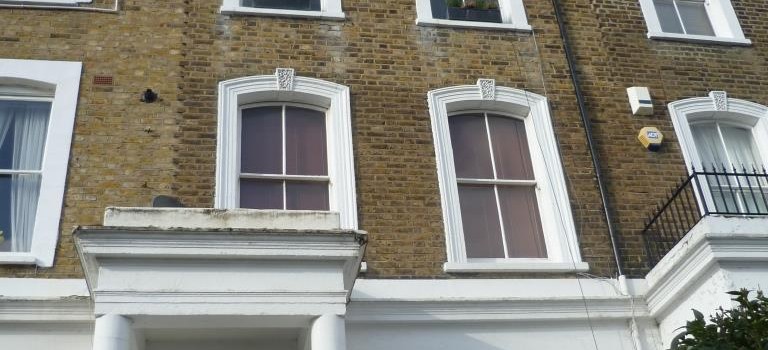
Why a period property is so expensive to run
On our day-to-day basis (with some 10,000 people visiting the website per day), we tend to get asked plenty of questions about ways to improve the energy efficiency of pre-1930 properties up and down the country. Properties built in this era tend to have a very specific construction type, which makes them slightly tricky to insulate, particularly in terms of wall insulation and it appears that major conurbations in Britain like Greater London, Birmingham West Midlands, Manchester Metropolitan area, Glasgow, etc are really is full of them!
In the winter, period properties (which were largely built from the late 1850’s to 1929) tend to be very draughty and poor at retaining heat when it is cold outside. As a result, they can be costly to run, requiring a lot of heating to keep them at a comfortable temperature. It can even be worse when the winter season drags its feet and the cold snap continues into March, April and parts of May. The resulting energy usage is estimated to be 15 – 20% higher than in normal years.
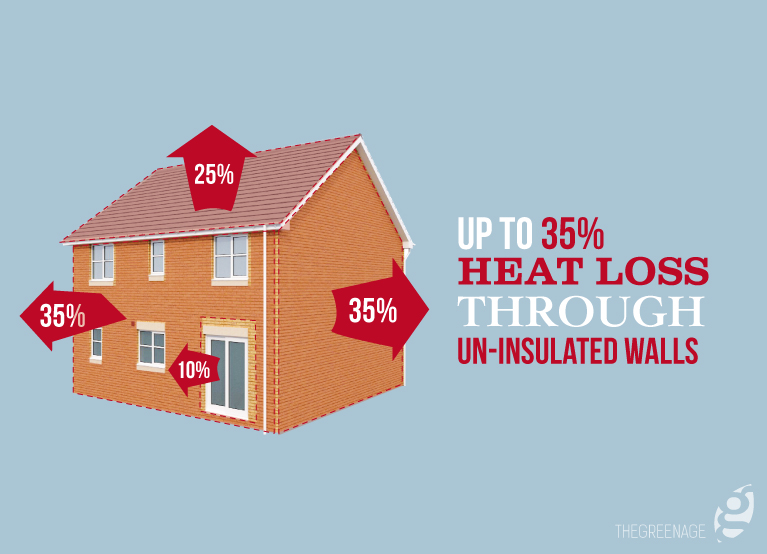
So you may have a well-insulated loft space and an efficient boiler, but you are still puzzled as to why the property is so bad at retaining heat. The answer is that uninsulated walls can account for 35% or more of the heat loss and unfortunately period properties, which are common across towns and cities, have solid brick walls that are simply terrible at retaining heat.
You can insulate a solid wall
The myth up to now has been that a solid wall cannot be insulated as a retrofit project, because it does not have a cavity that can be filled. This is simply not true. Whilst cavity walls (seen on houses post 1930) are definitely cheaper and easier to insulate (as cavity wall insulation can simply be pumped into the cavity), there are methods available for these old ‘solid’ walls to help them reach more modern energy saving standards.
How do you insulate a solid wall?
Solid wall insulation can work in two ways:
- You insulate the inside of the property, which is referred to as internal solid wall insulation;
- You insulate the outside walls of the property, using external solid wall insulation.
Internal insulation involves thickening the wall from the inside. The process entails adding insulation to the wall and then re-plastering to achieve a nice even finish. With internal wall insulation you just need to be a bit more aware that by adding insulation, the living area will be significantly reduced.
The precise amount of space you lose will vary depending on the degree of insulation. But be prepared to lose 50mm (2 inches at least) to the walls that face the outside exposed walls. The good news is that you don’t need to insulate party walls (the shared walls between adjacent properties) because in theory they are heating the wall from the other side, so no heat loss occurs across this. Therefore if you live in a mid-terrace property, you only need to worry about insulating the front and the back walls of the property.
A more widely used method of insulating solid walls is applying external wall insulation, which is essentially thickening the walls from the outside, then sealing the system with a range of render or brick slip finishes. When you are applying the render products, the finished walls may look different to their original appearance (unless they are already rendered). The render is textured and can be coloured with any colour depending on what you want. The property can also have brick slips installed on top of the insulation to allow the property not to deviate too much from a traditional brick look. However, brick slip systems tend to be quite expensive, which makes rendered finishes more popular and widely used up and down the country. The video below is an simplified demonstration on how the external wall insulation process works. It does not necessarily capture all the little details, but you will see the key layers that are applied externally to a wall. For more technical information please refer to an appropriate BBA certificate of an external wall manufacturer.
Solid wall insulation and aesthetics
Some of our readers tell us that they love the principle of external wall insulation, but they hate the reality of having to sacrifice property features to do so. Instead of going for the expensive brick slips, the property improver can potentially combine internal insulation at the front elevation (thereby preserving features at street level) with external insulation on the sides and back.
Working around these challenges for a period property will also get you through potential local authority planning hurdles – especially if you live in one of the large metropolitan areas. For example, London has a high proportion of listed properties and large areas that are covered by building restrictions. Therefore it is always worthwhile spending some time familiarising yourself with the rules and regulations covering your local area before you proceed on with your project.
What is the cost of solid wall insulation?
If you were to go to an installer today and inquire about getting solid wall insulation installed, you might be quite shocked by the cost. From data we have collected up and down the country, the price for the measure varies between £80 to £125m per m2, depending on the property and the final finish. Internal wall insulation costing varies between £70 to £95m2.
There are literally dozens of different variations to external wall insulation finishes. These range from the insulating material used (EPS, mineral wool, cork, etc), to the final topcoat, which can be acrylic (cheapest) or silicone based, to different types of brick slips or specialist finishes.
On the whole, looking purely at economic payback through energy bill savings (i.e. recouping the cost of installation will probably take 20 years + based on the energy savings it will provide), external wall insulation will not look sensible as a standalone metric. However, the external wall insulation system provides additional benefits – it improves the visual appearance of an old render properties and helps waterproof and protect the walls from penetrating damp.
Grants and subsidies for solid wall insulation – do they work?
The economics of solid wall insulation as a standalone indicator didn’t really work until the Government introduced the Green Deal. This was an energy efficiency scheme that was phased out in 2015, and will probably not come back in its previous form. Some homeowners benefited from a grant the Green Deal scheme offered, which essentially paid up to 75% of the total cost. The scheme did not achieve its aim of actually delivering a high volume of external wall insulation improvements up and down the country. This was because the rate of subsidy was set too high and was distributed by a very small number of ‘first come first served’ users.
We believe that external wall insulation not only lowers bills, but also adds value to the property and extends its lifespan. Therefore, if there is a future scheme launched in some shape or form, it has to look at beyond the traditional success indicators, and look at qualitative aims in addition to the economic arguments for it to be successful. A national scheme that is led purely by ‘free money’ does not create the right incentives for the consumer, or to the industry trying to deliver it.
Our prediction is that a future scheme will be based on the ‘pay-as-you-save’ or home improvement loan mechanisms, with very small and targeted amounts of carbon-saving grants. This scheme may have some Government involvement (from a regulation standpoint), but will be very much private-sector led. Expected launch in 2017-18.
Why is the government now not subsidising the cost of solid wall insulation?
The obvious point as to why the Government is not throwing any money at solid wall insulation is that it doesn’t have any money; and secondly, the cost of the measure is quite expensive, therefore requiring quite an outlay to make sure enough consumers out there can benefit from it. Therefore it is too difficult to go back down that road.
The Government is also trying to move away from sponsoring ‘flagship policies’ (Green Deal, Big Society, etc) and pushing more emphasis back on the industry or non-Government sectors to do what it has always done well, which is to deliver for its customers or members. The Government does have to meet carbon reduction targets, but the popular view is that some of those will be missed by 2020, with little worry about the political fall-out from doing so.
Cavity wall insulation and loft insulation are much cheaper energy efficiency measures to deliver to properties in the UK, and the limited ECO funding that is available is going towards some of those measures rather than solid wall insulation.
We are seeing only the most committed home owners or businesses go through the necessary steps to have solid wall insulation implemented on their properties. Very often it is this grouping that really understands the benefits of solid wall insulation and some of its long-term aims, that chooses to make the investment.
To find out more information about solid wall insulation, please see our solid wall insulation section or if you have specific questions, please send us an email to: mailbox@thegreenage.co.uk



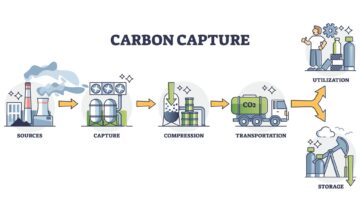
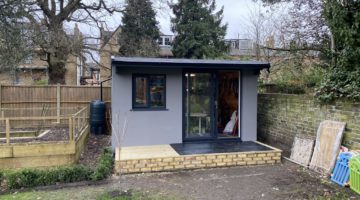
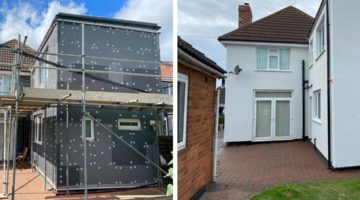
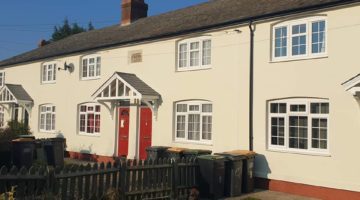





We are contemplating purchasing a Gregorian property run off-gas near Newbury, and want to make it as green as possible. What Government grants can we use to make the cost worth it for us? much obliged
Hi Mikhail, the GDHIF scheme is launching again in a few weeks which will give you a big grant towards the cost of solid wall insulation. In terms of heating – provided the house is really well insulated you might want to consider a heat pump – these run off electricity and are very efficient turning one unit of electricity into 4 units of useful heat ( a standard electricity convection heater makes one unit of heat for every unit of electricity). A heat pump also benefits from the Renewable heat incentive which pays you for every unit of hot water you produce (this should cover the initial install costs).
DEAR SIRS, I LIVE ABROAD AND I WILL PAY A SHORT VISIT TO LONDON FOR A PROPERTY/HOUSE I HAVE AT 74 CLAPHAM COMMON NORTH SIDE. ON SEPTEMBER 21ST I WILL BE IN THE AREA. THE HOUSE DUE TO SOME BRICKS OUTSIDE HAS HUMIDITY INSIDE AND PROBABLY NEEDS TO BE INSULATED AS ALSO THE EPC IS QUITE LOW. PLEASE LET ME KNOW HOW WE CAN PROCEED. WE YOU GO YOURSELVES TO SEE THE PROPERTY BEFORE I GET THERE? DO YOU WANT TO ARRANGE AN APPOINTMENT AT THE SPOT WITH ME? UNFORTUNATELY, MY TIME IS VERY LIMITED. URGENTLY PLEASE CONTACT ME.
idk lmfao